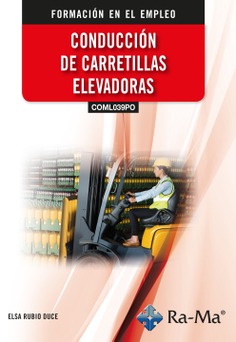(COML039PO) Conducción de carretillas elevadoras
Elsa Rubio Duce
El objetivo de este libro es que el lector adquiera las competencias y habilidades necesarias para la correcta conducción y manejo de carretillas elevadoras con control de las cargas total y seguridad en la tarea.
- Escritor
- Elsa Rubio Duce
- Colección
- Formación en el Empleo (Especialidades Formativas)
- Materia
- Gestión de la distribución y la lógistica
- Idioma
- Castellano
- EAN
- 9791387764838
- ISBN
- 979-13-87764-83-8
- Depósito legal
- M-16182-2025
- Páginas
- 236
- Ancho
- 17 cm
- Alto
- 24 cm
- Peso
- 371 g
- Edición
- 1
- Fecha publicación
- 02-09-2025
386,44 MX$21,06 US$
Índice de contenido
ACERCA DE LA AUTORA
INTRODUCCIÓN
CAPÍTULO 1. MANIPULACIÓN Y TRANSPORTE DE MERCANCÍAS
1.1 FLUJO LOGÍSTICO INTERNO DE CARGAS Y SERVICIOS. IMPORTANCIA SOCIOECONÓMICA
1.2 ALMACENAMIENTO, SUMINISTRO Y EXPEDICIÓN DE MERCANCÍAS
1.2.1 Almacenamiento de mercancías
1.2.2 Suministro de mercancías
1.2.3 Expedición de mercancías
1.3 NORMATIVA COMUNITARIA Y ESPAÑOLA SOBRE MANIPULACIÓN DE MERCANCÍAS
1.3.1 Normativa comunitaria (Unión Europea)
1.3.2 Normativa española específica
1.4 PREVENCIÓN DE RIESGOS LABORALES Y MEDIDAS DE SEGURIDAD EN EL TRANSPORTE DE MERCANCÍAS
1.4.1 Formación específica del personal
1.4.2 Uso obligatorio de Equipos de Protección Individual (EPI)
1.4.3 Señalización clara y efectiva
1.4.4 Correcta organización y distribución del espacio
1.5 MEDIOS DE TRANSPORTE INTERNOS Y EXTERNOS DE LAS MERCANCÍAS.
CONDICIONES BÁSICAS
1.5.1 Medios de transporte internos
1.5.2 Medios de transporte externos
1.6 SIMBOLOGÍA Y SEÑALIZACIÓN DEL ENTORNO Y MEDIOS DE TRANSPORTE: PLACAS, SEÑALES INFORMATIVAS LUMINOSAS, ACÚSTICAS
1.6.1 Placas y señales visuales
1.6.2 Señales luminosas
1.6.3 Señales acústicas
1.7 UNIDAD DE CARGA. MEDICIÓN Y CÁLCULO DE CARGAS
1.7.1 Peso total de la carga
1.7.2 Centro de gravedad
1.7.3 Carga máxima admisible de la carretilla
1.8 DOCUMENTACIÓN QUE ACOMPAÑA A LAS MERCANCÍAS
1.9 DOCUMENTACIÓN QUE GENERA EL MOVIMIENTO DE CARGAS. TRANSMISIÓN POR VÍAS DIGITALES.
1.10 AUTOEVALUACIÓN DE LA SECCIÓN
CAPÍTULO 2. EMBALAJE Y PALETIZACIÓN DE MERCANCÍAS
2.1 TIPOS DE EMBALAJES Y ENVASES
2.1.1 Embalajes retornables
2.1.2 Embalajes de un solo uso
2.2 CONDICIONES DE LOS EMBALAJES PARA LA PROTECCIÓN DE LOS PRODUCTOS
2.3 CONDICIONES DE LOS EMBALAJES PARA EL TRANSPORTE SEGURO DE LOS PRODUCTOS.
2.4 TIPOS DE PALETIZACIONES. APLICACIONES SEGÚN TIPOS DE MERCANCÍAS
2.4.1 Paletización homogénea.
2.4.2 Paletización heterogénea
2.4.3 Paletización por capas cruzadas (entrelazada)
2.4.4 Paletización columnar o en pila
2.4.5 Paletización en espiga o trenzada
2.4.6 Paletización en bloque o a granel
2.5 CONDICIONES QUE DEBEN CUMPLIR LAS UNIDADES DE CARGA
2.6 PRECAUCIONES Y MEDIDAS A ADOPTAR CON CARGAS PELIGROSAS
2.7 AUTOEVALUACIÓN DE LA SECCIÓN
CAPÍTULO 3. CARRETILLAS PARA EL TRANSPORTE DE MERCANCÍAS
3.1 CLASIFICACIÓN, TIPOS Y USOS DE LAS CARRETILLAS; MANUALES Y AUTOMOTORAS: MOTORES TÉRMICOS, MOTORES ELÉCTRICOS
3.1.1 Carretillas manuales
3.1.2 Carretillas automotoras
3.2 ELEMENTOS PRINCIPALES DE LOS DISTINTOS TIPOS DE CARRETILLAS
3.3 ELEMENTOS DE CONDUCCIÓN
3.3.1 Volante de dirección
3.3.2 Pedales
3.3.3 Palancas de control hidráulico
3.3.4 Cuadro de instrumentos o panel de control
3.3.5 Espejos y ayudas visuales
3.3.6 Señales acústicas y botones de seguridad.
3.4 INDICADORES DE CONTROL DE LA CARRETILLA
3.4.1 Indicador de carga de batería (en carretillas eléctricas)
3.4.2 Indicador de combustible (en carretillas térmicas).
3.4.3 Testigo de temperatura del motor
3.4.4 Testigo de mantenimiento o fallo técnico.
3.4.5 Horómetro (contador de horas de trabajo)
3.4.6 Luces de advertencia o testigos de seguridad.
3.5 SEÑALES ACÚSTICAS Y VISUALES DE LAS CARRETILLAS
3.5.1 Señales acústicas: tipos y aplicaciones
3.5.2 Señales visuales: elementos y características
3.6 MANTENIMIENTO BÁSICO E INDICADORES DE FUNCIONAMIENTO INCORRECTO
3.7 AUTOEVALUACIÓN DE LA SECCIÓN.
CAPÍTULO 4. MANEJO Y CONDUCCIÓN DE CARRETILLAS
4.1 EJE DIRECTRIZ
4.2 ACCESO Y DESCENSO DE LA CARRETILLA.
4.3 USO DE SISTEMAS DE RETENCIÓN, CABINA, CINTURÓN DE SEGURIDAD
4.4 PUESTA EN MARCHA Y DETENCIÓN DE LA CARRETILLA
4.5 CIRCULACIÓN: VELOCIDAD DE DESPLAZAMIENTO, TRAYECTORIA, NATURALEZA Y ESTADO DEL PISO ETC.
4.6 MANIOBRAS. FRENADO, APARCADO, MARCHA ATRÁS, DESCENSO EN PENDIENTE
4.6.1 Frenado
4.6.2 Aparcado
4.6.3 Marcha atrás
4.6.4 Descenso en pendiente
4.7 ACELERACIONES, MANIOBRAS INCORRECTAS
4.8 MANIOBRAS DE CARGA Y DESCARGA
4.9 ELEVACIÓN DE LA CARGA
4.10 AUTOEVALUACIÓN DE LA SECCIÓN
CAPÍTULO 5. CARGA Y DESCARGA DE MERCANCÍAS
5.1 ESTABILIDAD DE LA CARGA. NOCIONES DE EQUILIBRIO
5.2 LEY DE LA PALANCA
5.2.1 El centro de carga
5.3 CENTRO DE GRAVEDAD DE LA CARGA
5.4 PÉRDIDA DE ESTABILIDAD DE LA CARRETILLA
10 MANIPULACIÓN DE CARGAS CON CARRETILLAS ELEVADORAS. EDICIÓN 202
5.5 EVITACIÓN DE VUELCOS TRANSVERSALES O LONGITUDINALES
5.5.1 Vuelco longitudinal
5.5.2 Vuelco transversal
5.6 COMPORTAMIENTO DINÁMICO Y ESTÁTICO DE LA CARRETILLA CARGADA
5.6.1 Comportamiento estático
5.6.2 Comportamiento dinámico
5.7 COLOCACIÓN INCORRECTA DE LA CARGA EN LA CARRETILLA
SOBRECARGA
5.8 MODOS DE COLOCACIÓN DE LAS MERCANCÍAS EN LAS ESTANTERÍAS
5.8.1 Colocación directa sobre largueros
(paletización convencional)
5.8.2 Apilamiento en bloque (sin estantería)
5.8.3 Colocación en estanterías dinámicas o por gravedad
5.8.4 Almacenamiento cantiléver
5.9 AUTOEVALUACIÓN DE LA SECCIÓN
RESUMEN
GLOSARIO
AUTOEVALUACIÓN FINAL
Libros relacionados
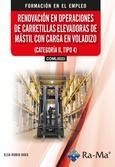
(COML0023) Renovación en operaciones de carretillas elevadoras de mástil con carga en voladizo (Categoría II, Tipo 4)
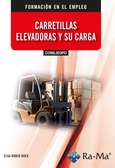
(COML003PO) Carretillas elevadoras y su carga
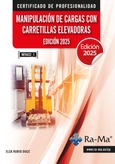
(MF0432_1) Manipulación de cargas con carretillas elevadoras. Edición 2025
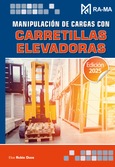
Manipulación de cargas con carretillas elevadoras. Edición 2025

Industria y Logística 4.0
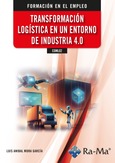
(COML02) Transformación Logistica en un entorno de industria 4.0

